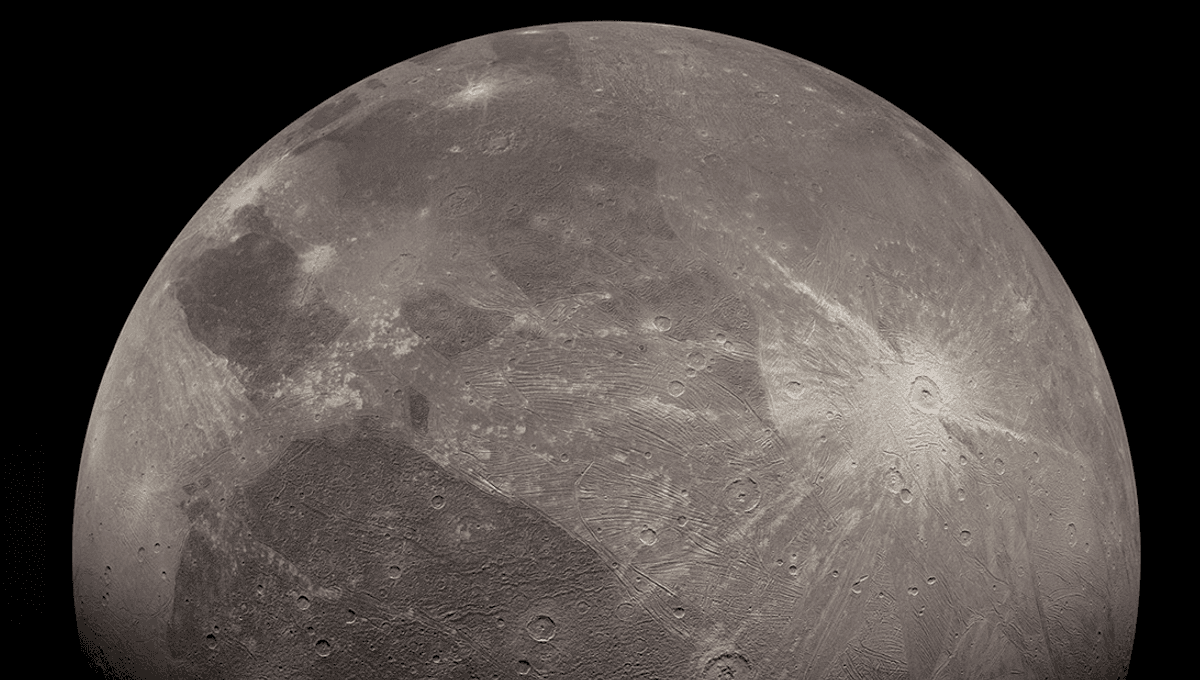
The Solar System’s largest moon could be a dark matter detector, according to a new paper. All we have to do is look.
As far as astronomers studying the observable universe can tell, only around 5 percent of it is made up of matter. The rest, or the overwhelming majority of it, is made up of dark matter (around 27 percent) and dark energy (around 68 percent).
Dark matter is invisible matter that doesn’t emit its own light and only interacts with normal matter through gravity, which we can see evidence for in galaxies and galaxy clusters. But given that there appears to be five times as much of it as regular matter, scientists are of course on the hunt for direct evidence of its existence.
The problem is, there are quite a few dark matter candidates, from Axions and weakly interacting massive particles (WIMPS) to sterile neutrinos and primordial black holes. Scientists have come up with ways in which to detect many of these candidates, or at least experiments that could be performed in the future, but so far have fallen short of detecting any likely dark matter particles or their by-products.
Of particular difficulty is detecting larger dark matter candidates, such as primordial black holes, solitons, strangelets, and others.
“While the majority of attention has focused on the search for new particles with intrinsically weak interactions, an alternative paradigm, known as macroscopic dark matter, suggests that dark matter may instead be composed of high-mass macroscopic objects with sufficiently low number density to evade current detection efforts,” the new paper explains.
If dark matter is less abundant but also larger, it could require a much more massive detector, such as a planet or a moon. In the new paper, William DeRocco, a Post-Doctoral Associate at the University of Maryland, suggests we may already have an ideal experiment orbiting Jupiter: Ganymede, the largest moon in the Solar System.
Experiments have been performed that have ruled out certain masses that these dark matter candidates can be. However, there are still more masses to probe that have not been ruled out yet.
“A large open parameter space remains for such DM [dark matter] candidates in the range of 1012 − 1022 g and densities ranging from atomic (1 g/cm3) to nuclear (1014 g/cm3). This is an exceptionally challenging parameter space to probe, as the high mass leads to a correspondingly small number density in the Galaxy, with, e.g., only one 1014 g DM constituent passing through the Earth every ≈ 105 years,” DeRocco explains. “As a result, any attempt to search for such DM requires enormous detectors with long integration times.”
Icy moon Ganymede, being larger than Mercury and largely unchanged over the course of 2 billion years, may be particularly suited to this task.
“Critically, due to its compositionally differentiated subsurface layers, DM collisions with the moon can release deep subsurface material that traditional impacts cannot, providing a critical signature by which to discriminate DM interactions from conventional ones.”
If macroscopic dark matter candidates have hit Ganymede, we should be able to see signs of it. According to DeRocco’s work, which has not yet been peer reviewed, the upcoming Jupiter Icy Moons Explorer (Juice) and Europa Clipper would be capable of detecting such signatures with their high-resolution spectral imagers.
“Of particular note would be small craters (≲ 10 km) with an anomalously large amount of melt volume displaying composition significantly different to that of surrounding regions,” DeRocco adds, “since such features would be difficult to explain via conventional cratering.”
DeRocco focused on vertical impacts for model simplicity, but suggests that shallower impacts could be even more visible to these spacecraft.
Though interesting, this study focuses on macroscopic dark matter, which is less fashionable with physicists at the moment than light and ultralight dark matter candidates. Looking closer at Ganymede may help us find evidence of such a candidate, or help to constrain our search. Assuming the results are inconclusive or find nothing, the Jupiter probes will still have a place to look for other candidates, with Jupiter itself also being suggested as a potential dark matter detector.
The study is posted to pre-print server arXiv.
Source Link: The Largest Moon In The Solar System Could Be A Dark Matter Detector